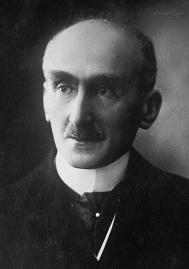Antoine Henri Becquerel (15 December 1852 – 25 August 1908) was a French physicist, Nobel laureate, and the discoverer of radioactivity along with Marie Skłodowska-Curie and Pierre Curie, for which all three won the 1903 Nobel Prize in Physics.
Early life
Becquerel was born in Paris into a family which produced four generations of scientists: Becquerel's grandfather (Antoine César Becquerel), father (Alexandre-Edmond Becquerel), and son (Jean Becquerel). He studied engineering at the École Polytechnique and the École des Ponts et Chaussées. In 1890 he married Louise Désirée Lorieux.
Career
In 1892, he became the third in his family to occupy the physics chair at the Muséum National d'Histoire Naturelle. In 1894, he became chief engineer in the Department of Bridges and Highways.
Becquerel's earliest works centered around the subject of his doctoral thesis: the plane polarization of light, with the phenomenon of phosphorescence and absorption of light by crystals.
Becquerel's discovery of spontaneous radioactivity is a famous example of serendipity, of how chance favors the prepared mind. Becquerel had long been interested in phosphorescence, the emission of light of one color following a body's exposure to light of another color. In early 1896, in the wave of excitement following Wilhelm Conrad Röntgen's discovery of X-rays the previous fall, Becquerel thought that phosphorescent materials, such as some uranium salts, might emit penetrating X-ray-like radiation when illuminated by bright sunlight. His first experiments appeared to show this.
By May 1896, after other experiments involving non-phosphorescent uranium salts, he arrived at the correct explanation, namely that the penetrating radiation came from the uranium itself, without any need for excitation by an external energy source.
There followed a period of intense research into radioactivity, including the discovery of additional radioactive elements thorium, polonium and radium, the latter two by Becquerel's doctoral student Marie Skłodowska-Curie and her husband Pierre Curie.
In 1903, Becquerel shared the Nobel Prize in Physics with Pierre and Marie Skłodowska-Curie "in recognition of the extraordinary services he has rendered by his discovery of spontaneous radioactivity".
As often happens in science, radioactivity came close to being discovered nearly four decades earlier in 1857, when Abel Niepce de Saint-Victor, who was investigating photography under Michel Eugène Chevreul, observed that uranium salts emitted radiation that could darken photographic emulsions. By 1861, Niepce de Saint-Victor realized that uranium salts produce "a radiation that is invisible to our eyes". Niepce de Saint-Victor knew Edmond Becquerel, Henri Becquerel's father. In 1868, Edmond Becquerel published a book, La lumière: ses causes et ses effets (Light: Its causes and its effects). On page 50 of volume 2, Edmond noted that Niepce de Saint-Victor had observed that some objects that had been exposed to sunlight could expose photographic plates even in the dark. Niepce further noted that on the one hand, the effect was diminished if an obstruction were placed between a photographic plate and the object that had been exposed to the sun, but " … d'un autre côté, l'augmentation d'effet quand la surface insolée est couverte de substances facilement altérables à la lumière, comme le nitrate d'urane … " ( … on the other hand, the increase in the effect when the surface exposed to the sun is covered with substances that are easily altered by light, such as uranium nitrate … ).
Honors and awards
In 1908, the year of his death, Becquerel was elected Permanent Secretary of the Académie des Sciences. He died at the age of 55 in Le Croisic.
The SI unit for radioactivity, the becquerel (Bq), is named after him. There is a crater called Becquerel on the Moon and also a crater called Becquerel on Mars.
He also received the following awards besides the Nobel Prize for Physics (1903):
- Rumford Medal (1900)
- Helmholtz Medal (1901)
- Barnard Medal (1905)
- Toffie Medal (1908)

